Orange Production Decline in Brazil Threatens Juice Supply
In the Engenheiro Coelho region of Sao Paulo, Brazil, oranges are moving down a conveyor belt at a packing house. However, this year, orange production in Brazil is facing a significant challenge, set to be the lowest in two decades. This decline is compounded by earlier droughts and tree losses, painting a grim picture for the orange industry.
The situation has caught the attention of juice makers worldwide. According to Fundecitrus, a Brazilian research association formed by citrus growers and manufacturers, the crop is bracing for a steep decline in production. Fruit diseases, machines, pests, and inclement weather along the citrus belt of Brazil’s São Paulo and Minas Gerais regions are causing a “physiological drop” in orange tree harvesting. As a result, prices are skyrocketing, putting pressure on the industry.
Global Impact on Orange Production
Brazil is the leading orange producer and exporter globally. The orange crop production in the region is projected to decline by nearly 25% between 2024-2025, according to the fund. Last year, the crop season produced 307 million boxes, while this season is projected to drop to 233 million boxes. If this prediction holds true, it will mark the second smallest crop harvest since the late 1980s when the association first began conducting forecasts in the citrus belt region.
It’s not just Brazil feeling the strain. The U.S. Department of Agriculture (USDA) has reported a 5% decline in citrus production in Florida, one of the country’s leading orange producers. This scarcity has driven the price of orange juice to record highs, impacting consumers worldwide.
Adapting to the Orange Shortage
With the world’s leading orange-producing countries forecasting a decline, juice makers are considering alternative solutions. Kees Cools, president of the International Fruit and Vegetable Juice Association, suggests that the industry may need to lean on other citrus fruits to meet consumer demand while cutting costs. He mentioned in a statement to ABC News that supplementing oranges with mandarins could be a viable option. By incorporating “a different species of fruit,” he believes they can maintain the naturalness and image of the product.
Image/Photo credit: source url





